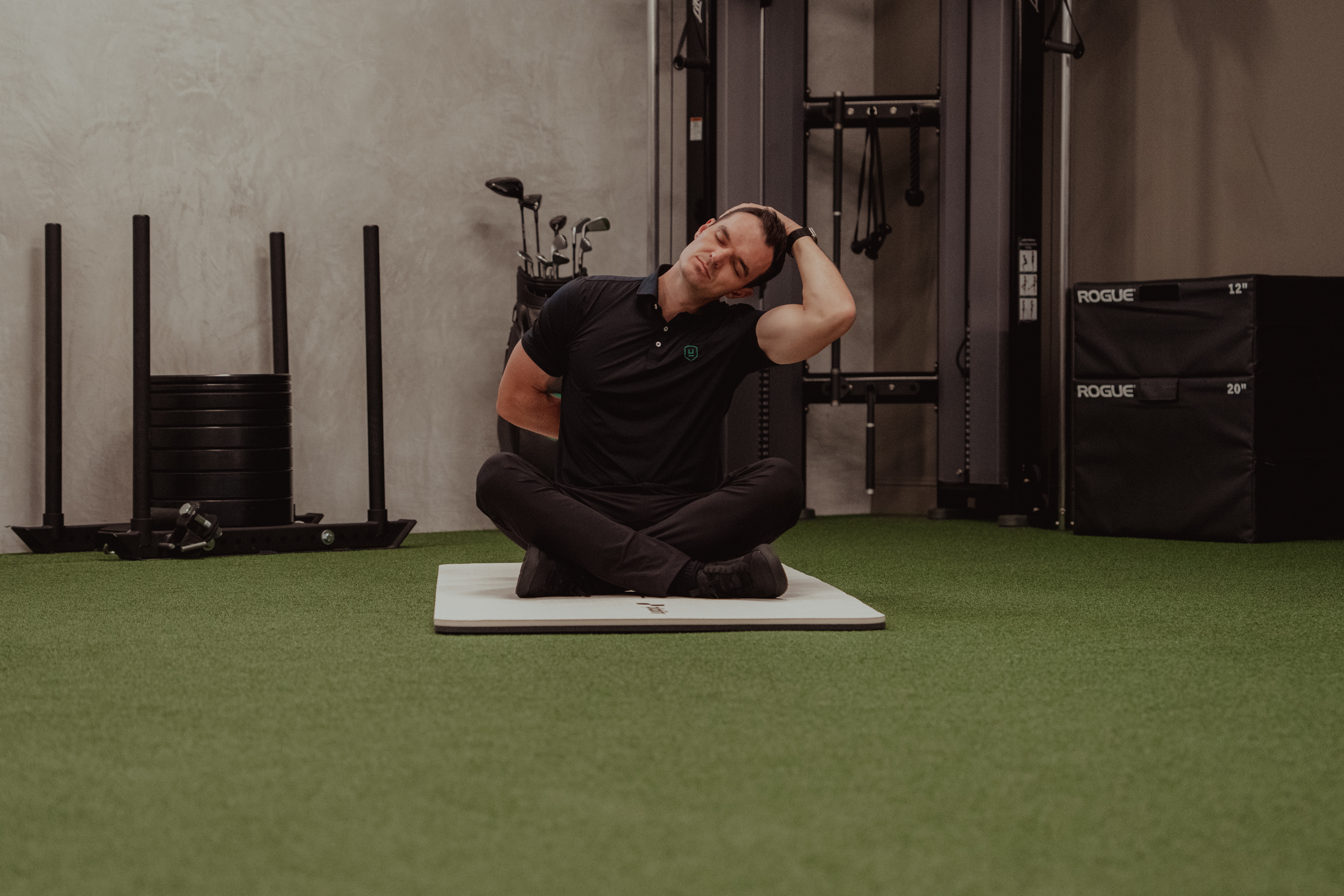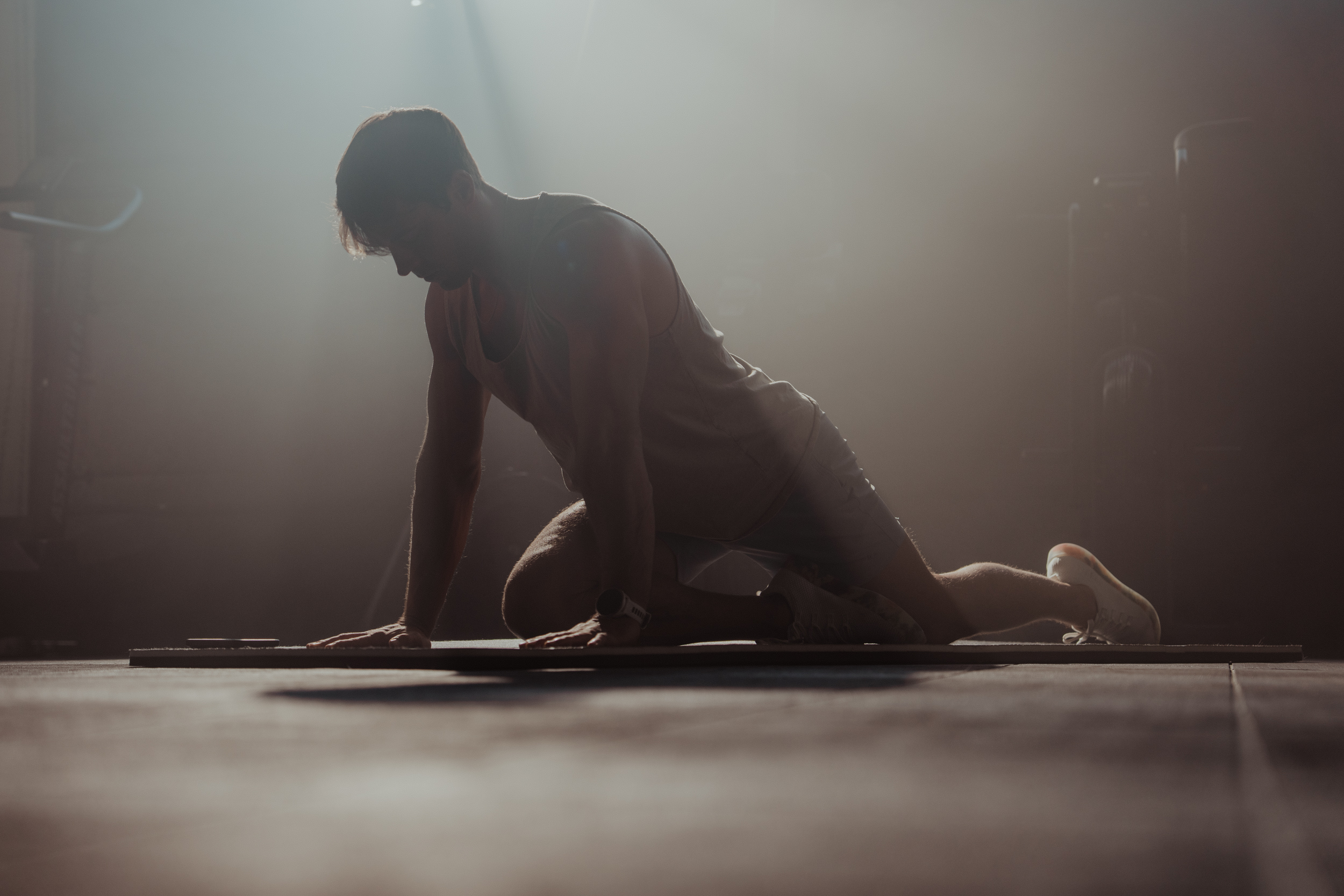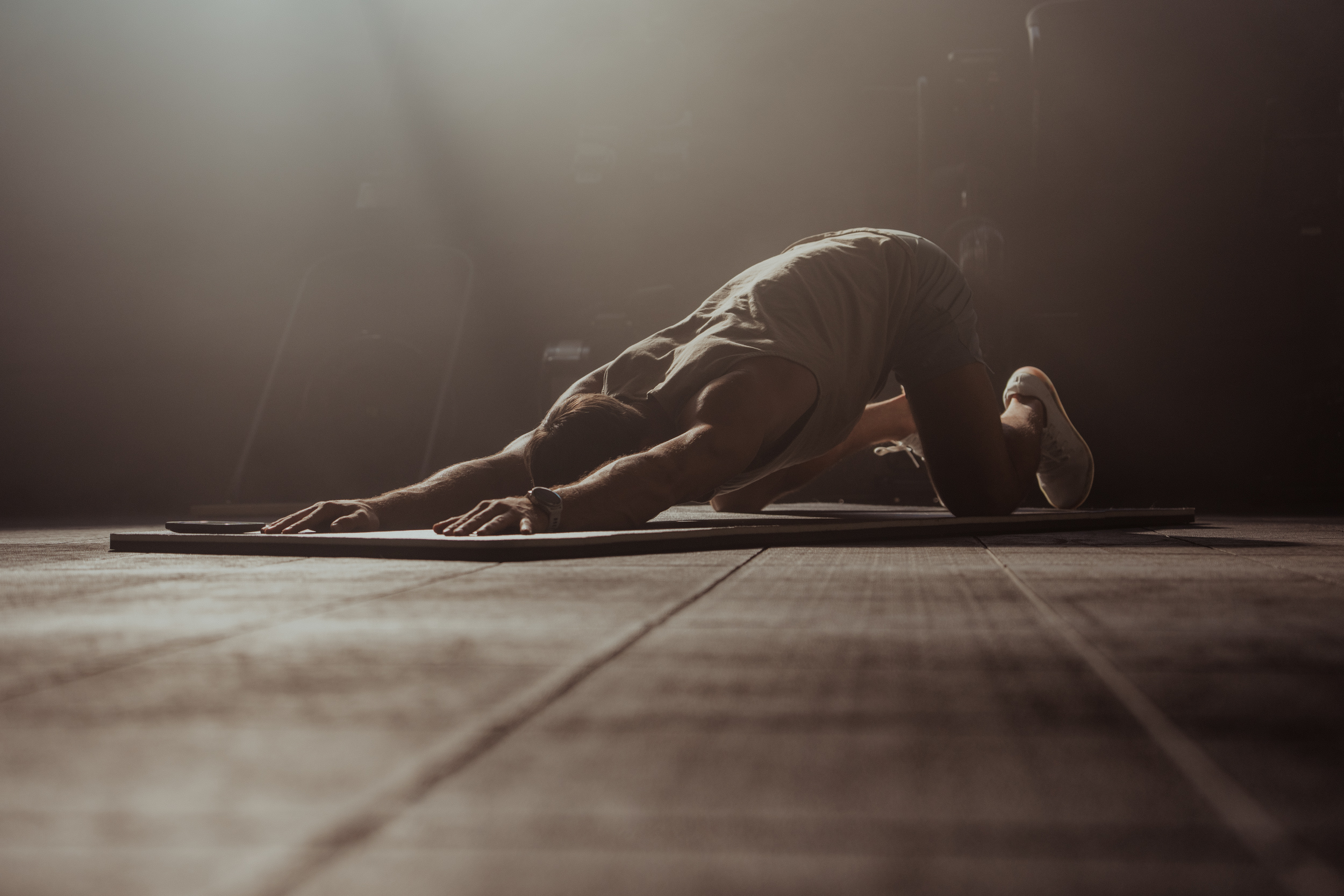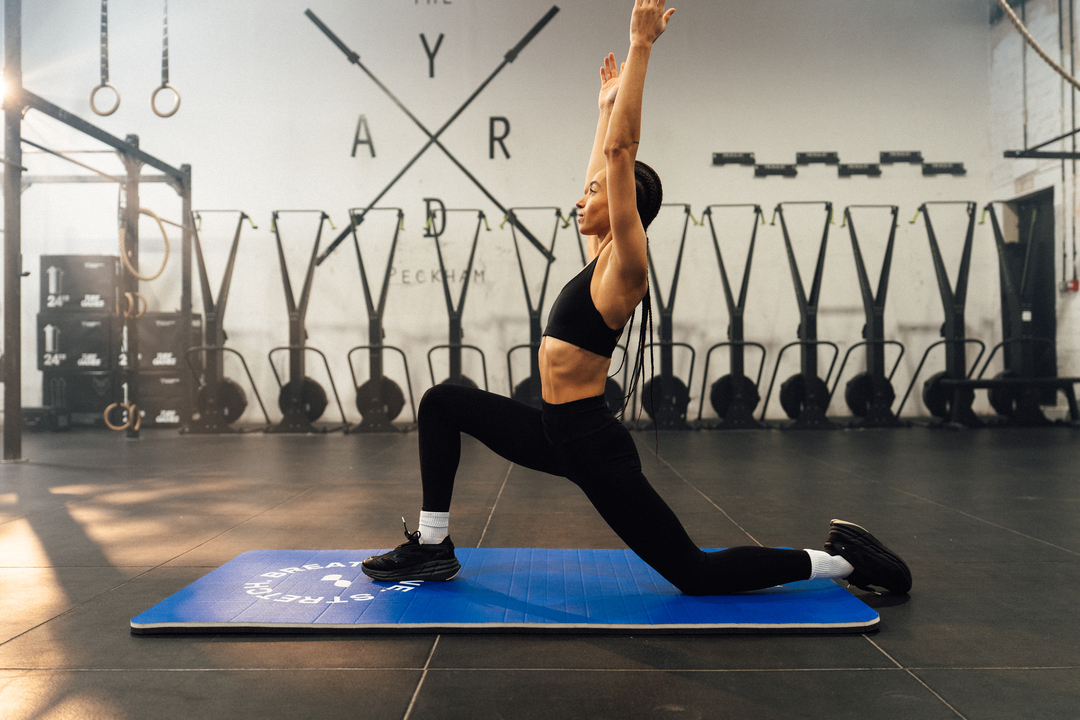Have you ever felt a sharp twinge in your muscles while stretching? You’re not alone. Many people experience discomfort when stretching, which can lead to an aversion to this crucial exercise. But why does stretching hurt? Is this discomfort a sign to stop? Or could it be a sign of progress? In this blog, we’ll not only cover why stretching can be painful, but we’ll also help you distinguish between helpful discomfort and harmful pain. Finally, we’ll provide strategies to stretch safely without risking injury.
Pliability's mobility app can help you achieve your goals by providing personalized insights that help you better understand why stretching hurts, learn how to differentiate between helpful and harmful muscle pain, and safely improve your flexibility.
Why Does Stretching Hurt, And Should You Be Worried About It?

Stretching can be hard, and yes, you can feel discomfort. I always tell my students when I see the grimace on their faces as they move through something tough and tight, “Way to go… I am really excited for you!” It should feel good in a bad way or bad in a good way.
Listen to Your Body While Stretching
We should never strain to stretch, though. If we allow our bodies to talk to us and show us what’s going on inside, it will direct us on how to heal it. This is all to say that it’s essential to understand the sensations you’re feeling while stretching.
If you’re experiencing actual pain, that’s your body’s way of telling you that something isn’t right. Addressing the issue before moving on will not only help you progress faster but also ensure you don’t get injured. Win-win!
What Painful Sensations Should You Be Wary Of?
Ideally, you don’t want to feel:
- Anything sharp and stabby.
- Tingling or numbness in your extremities.
- Joint pain, as if your joints are stuck or crunching.
- Anything that makes you want to act like Kylo Ren.
These are all things you might feel when your body is telling you something isn't working correctly. I’ll explain what each sensation could mean a little later, but first, let’s discuss the flip side.
What’s “Normal” When Stretching?
Feelings that are often classified as “pain," but are ok.
- A sore/tight muscle being stretched and lengthened
- A muscle engaging that's helping support the stretch, but that you've never engaged before
- Productive discomfort from something new and challenging
These are each very different and not harmful. Understanding the difference between productive discomfort and actual pain is super important. If you can clarify these sensations for yourself and your coach, you’ll be in better shape!
OK, wait, so what do these "painful" sensations mean, anyway?
Great question! I wouldn't be able to explain every single possible sensation you could ever feel, but here are some of the usual suspects:
Stretching and Nerve Tension: What to Watch For
Tingly/loss of sensation in extremities/zappy = Nerve tension. The most common nerve tension I see in students is sciatic nerve tension, which you'll experience when doing forward folds/pikes (especially with feet flexed). You also may experience nerve tension in your arms and the front of your legs.
This article explains more about stretching with sciatic nerve tension. Just note that if you feel any of these sensations in your feet, hands, legs, or arms while stretching, the "pain" is coming from nerve tension that you don't want to push through! (Any half-decent physio should be able to diagnose and help ease your nerve tension)
Feeling Stuck While Stretching? It Might Be Alignment
Joint-related "blocking" or stuck feeling = Lazy muscles or lack of proper alignment. Most of the time, joints feel stuck from a lack of strength or engagement in the supporting muscles. But it can also be from alignment problems. People often run into impingements when the alignment or technique is off.
For example, if you feel a firm pinch in the shoulder joint when doing shoulder stretches with your arms overhead, that's an impingement in your shoulders. Try pushing your shoulders UP as much as possible, and the impingement should go away, allowing you to feel more of a stretch through your armpits/lats!
Overstretching? Weak Muscles Might Be to Blame
Overstretching as soon as you start stretching = Weak muscles. Muscles that are weak or deconditioned tend to resist being stretched. Your body will perceive danger because the muscles themselves aren't strong enough to be stretched safely.
So if you start working on your splits and right away start to feel like I've overstretched (or tighten up right away, that's one way your body will try to protect itself), take a step back and focus on building more strength in your hamstrings, hip flexors, and glutes.
There are, of course, more sensations you could feel. But these are pretty common ones, and a good starting point for understanding "painful" sensations.
What Should Stretching Feel Like?
During a productive stretch session, it should feel like you're stretching the muscles you intend to stretch and working the muscles you intend to work. For instance, if you're doing a pike stretch/forward fold, you should feel your hamstrings stretching and your quads working.
It shouldn't hurt. There should be no zappy, tingly, sharp sensations if you're feeling slight discomfort because a muscle is being lengthened or you're experiencing new, yet productive sensations... fine!
Related Reading
- Body Awareness
- What is Functional Movement
- Functional Strength Training
- Does Yoga Help With Mobility
- How Long Does It Take to Improve Flexibility
- Why is Range of Motion Important
- How to Fix Tight Hamstrings
Stretching Mistakes That Hurt and How to Avoid Them

Stretching seems simple enough, but if you aren’t careful, you could be harming your body instead of helping it. Here are some common stretching mistakes to avoid to keep your body safe and healthy.
Overstretching
Even if you’re not tying yourself in knots like dancers, gymnasts, and yogis do, it’s possible to stretch too much. (And yes, super-bendy professionals also need to be careful they don’t push beyond what’s safe, although their threshold might look different from yours.)
Why Forcing a Stretch Can Lead to Injury
“Overstretching is stretching beyond your joints’ normal range of motion,” says Katie Sun Worrall, a physical therapist and dance medicine specialist at Milestone Physical Therapy in Roseville, California.
When you force a stretch past your limits, by pushing it too far or holding the position for too long, you stretch the ligaments surrounding your joints rather than the muscle you’re targeting, Worrall says. This increases joint laxity (or hypermobility) and makes your joints less stable, which can lead to injury.
When Stretching Isn’t the Solution to Pain
According to board-certified sports physical therapist Leada Malek, author of Science of Stretch, overstretching is more common than you might think, and she says she sees people fall victim to the habit in two common scenarios, neither of which involves taking a nap while sitting in a split.
The first is when people assume that stretching is the solution for a tight-feeling muscle or body pain they’re experiencing. “People seek out stretch options to treat something that may need more than that, only to find stretching excessively has not helped or made things worse,” she says. If you are unsure whether to stretch a muscle (especially if you are experiencing pain), you should consult with your doctor or physical therapist before trying a stretch or exercise.
Don’t Let Mobility Training Lead to Overstretching
The second reason people overstretch, which Malek says she’s seeing with increasing frequency, is that they become overly enthusiastic about the benefits of mobility training and neglect a well-rounded fitness plan.
“With the latest trend of improving mobility, people seem to hang their hats on stretching more than before as a means of chasing this mobility,” she says. Mobility is a key aspect of any training program, but try not to neglect other areas that can round out your training, including strength and cardiovascular training.
How Overstretching Happens
There are several ways you can overstretch your muscles. “Overstretching can occur when the length of a tissue surpasses its ability to control the length, or when you push past a point of control,” says Malek.
“Pushing the limit of a stretch too aggressively, essentially straining a muscle, or stretching for too long or too often can be precursors [to overstretching]. Holding a stretch, especially one that already has the joint at its near-end range motion, can also be an issue as well.” Let’s take a look at these habits that can lead to overstretching in a little more detail.
Stretching Past Your Limits
“My definition of overstretching is that you're stretching your joints and your muscles beyond where they should be,” says Worrall. Gains in flexibility should be made slowly and incrementally. You stretch your muscle to its capacity (gently!), and then give it time to recover before stretching it further. Over time, your target muscle will gradually increase its capacity to lengthen.
If you force a stretch past its natural limit, say, a partner presses firmly on your back to increase a seated hamstring stretch to the point where you feel pain, any range-of-motion gains you see will be because the ligaments that connect your muscles to your joint are straining and possibly tearing.
Stretching With Too Great an Intensity
Similar but different from stretching past your limits is stretching with too much intensity. Intensity in stretching refers not to the position of your muscles, but to “the magnitude of force or torque applied to the joint during a stretching exercise,” according to the authors of a study published in the journal Sports Health. Put another way, it’s the amount of pressure or strain you’re putting on your joints in a stretch.
One way that people commonly subject their joints to too much intensity while stretching is by pulsing or bouncing in the stretch. Both the American Academy of Orthopaedic Surgeons and the American College of Sports Medicine recommend against bouncing in your stretches (aka ballistic stretching) because this added force exerted on your joints can cause injury.
Stretching for Too Long
Malek recommends that most people hold static stretches for 30 to 60 seconds at a time. Hold for longer than this, and you could see diminishing returns in your performance. “What happens when you hold a stretch for too long is you relax your muscle and it actually makes it harder for it to contract,” says Worrall.
So then, when you need that muscle to contract during your workout, something that’s necessary for all movement, it responds more slowly and has a diminished capacity. Prolonged stretching may be recommended for individuals who are specifically looking to increase flexibility, but should be done under the guidance of a medical or certified fitness professional, Malek adds.
Stretching a Cold Muscle
You might also subject your muscles and joints to overstretching if you attempt static stretching before you’re adequately warmed up. Because cold muscles are more likely to tear, according to Harvard Health, you should take 5 to 10 minutes to get your blood pumping through your muscles before you try to reach for your toes. You could go for a brisk walk or do some dynamic stretches, like walking lunges or arm circles.
Stretching Too Much: Signs You May Be Overstretching
The telltale sign that you’ve pushed your stretching too far is if you feel pain. “Stretching can be uncomfortable, but it shouldn’t be painful,” says Malek.
Okay, but what if you’re reading this and thinking to yourself, “Uh, I’m no gymnast and stretching always hurts…” You’ve got a point, it’s not always super obvious which aches are to be expected and which are a signal to rein things in.
How to Tell If You’re Stretching Too Much
Malek describes some key indicators that the sensation you’re experiencing is a warning sign: “If you get any numbness or tingling, sharp pain, you catch yourself holding your breath or wincing during the stretch, or you have symptoms of pain or discomfort that linger after, can all be signs you overdid it,” she says.
While every person’s pain threshold is different, Worrall recommends trying to place the pain you feel on a scale of 1 to 10. “If it’s not a sharp pain, but a dull, achy pain below a three out of 10, you’re likely safe,” she says. “If it’s above that and it’s starting to get sharp or it increases, then you should probably back off.”
Overstretching Can Hurt Performance and Power
Another indicator that you have overstretched is if you begin to see your athletic performance slump. According to Malek, research has shown that holding a static stretch for longer than 60 seconds “can affect how quickly and efficiently the nervous system fires up the muscles and that it may decrease the stiffness of the muscle-tendon unit, which can impact force and power output of exercises like jumping.”
Malek adds that if you overstretch to the point where you cause a muscle strain, meaning the muscle fibers are pulled farther than they can go and tear as a result, your body will initiate an inflammatory response to heal the damage (remember, inflammation occurs when your immune system responds to threats). “When this happens, your muscles are unable to produce as much force, as the tear [and inflammatory response] limits contractility.”
What Should You Do If You Overstretch?
So, your muscles are feeling sore the day following a stretch sesh, and you have a hunch it’s because you overstretched. What now?
“Firstly, always seek help from a physical therapist or other rehab professional,” says Malek. “But in general, you can take it easy.” Your overstretched muscle needs time to heal and regain its strength, so you want to give it time to do so.
Recovering from Overstretching: What to Do Next
“Move within your abilities, perhaps engage in manageable strength training, and opt not to spend time stretching that same tissue again beyond a gentle stretch if desired and safe,” Malek says.
While Malek says it’s unlikely you’ll need to immobilize the muscles or joints you overstretched, if you are feeling acute pain that is impacting your ability to move, research supports using the RICE protocol for recovery:
- Rest
- Ice
- Compression
- Elevation
How Overstretching Impacts Your Fitness Routine
Stretching is an integral part of your fitness routine. Not only does increasing the range of motion in your joints help you get more from your workouts, but it makes it easier for you to do everyday tasks like carrying my groceries, going up stairs, or getting on the floor to play with my kids.
Stretching Benefits Fade When You Push Too Far
“Other perks associated with stretching include reduction in sedentary activity, improved neuromuscular control, positive effects on mental health, pain reduction, and things like possible improvements in sleep quality, nerve-related pain, and work-related pain,” says Malek.
Many of these benefits go out the window if you force your body into positions that are beyond its capabilities or hold a stretch for too long; this is because overstretching can strain your muscles and increase laxity in your joints, which makes them unstable. Just think, if your ankles are loose, for instance, it’s easier to roll or tweak them when going for a run or a hike.
Prevent Overstretching by Tuning In to Your Body
The best way to avoid overstretching is to learn how to listen to your body. Stretch slowly, deliberately, and with control. Try doing a body scan at the beginning of your workout and then again at the end.
Ask yourself, "How do I feel? Am I noticing any soreness or stiffness?" The more you check in with yourself, the better you come to know what feels good and right, and what feels like too much.
Related Reading
- How to Get a Crook Out Your Neck
- Loss of Mobility
- How Does Flexibility Work
- Flexibility Gymnastics
- Are Women More Flexible Than Men
- What is the Impact of Age on Flexibility
- What is Passive Stretching
Improve Your Flexibility with Our Mobility App Today | Get 7 Days for Free on Any Platform

To avoid pain or injury while stretching, start slowly. If you’re just beginning a mobility routine, don’t push yourself too hard to improve your flexibility. Instead, ease into the process and allow your body time to adjust.
Focus on gentle stretches and static holds that feel comfortable. After a few days, you can begin to increase the intensity of your stretching routine gradually. If you’re feeling pain, especially sharp or intense pain, stop immediately.
Improve Mobility Safely with Pliability
Listen to your body and pay attention to any signals it may be sending. If you’re struggling with mobility, consider using an app like Pliability to help you gently and safely improve your flexibility and joint function.
Pliability offers a fresh take on yoga, tailored for performance-oriented individuals and athletes. Our app features a vast library of high-quality videos designed to improve flexibility, aid recovery, reduce pain, and enhance range of motion.
Pliability: Personalized Mobility Programs, Free for 7 Days
Pliability provides daily-updated custom mobility programs for those interested in optimizing their health and fitness. It also includes a unique body-scanning feature to pinpoint mobility issues. If you're feeling limited by pain or the ability to move, Pliability aims to complement your existing fitness routine and help you move better.
Sign up today to get 7 days absolutely for free, on iPhone, iPad, Android, or on our website to improve flexibility, aid recovery, reduce pain, and enhance range of motion with our mobility app.
Related Reading
- What is Static Exercise
- Dynamic Movement
- Yoga Poses for Flexibility
- Hip Opening Yoga Poses
- Proprioception Exercises
- Neck Mobility Exercises
- Flexibility Goals Examples



.jpg)
.jpg)
.jpg)


